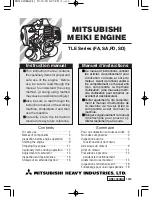
19.1.2 HT circuit
The HT circuit cools the cylinders and cylinder heads.
A centrifugal pump (7) pumps the water through the HT circuit.
From the pump the water flows to the distributing duct, cast in
the engine block. From the distributing ducts the water flows to
the cylinder water jackets, further through connection pieces to
the cylinder heads where it is forced by the intermediate deck to
flow along the flame plate, around the nozzle and the exhaust
valve seats, efficiently cooling all these components. From the
cylinder head the water flows through the multiduct to the
collecting duct, if a two stage charge air cooler the water flows
through the charge air cooler to the temperature control valve
maintaining the temperature at the right level.
Depending on the type of turbocharger used, parallel to the flow
to the cylinders, part of the water flows to the turbocharger.
19.1.3 Venting and pressure control of HT-circuit
For venting the system the turbocharger cooling water pipes and
a venting pipe from the multiducts are connected to a box (12).
From this box the vent pipe leads to the expansion tank (11) from
which the expansion pipe is connected to the inlet pipe of the
pumps (7 and 8). A static pressure of 0.7 - 1.5 bar is required before
the pumps. If the expansion tank cannot be located high enough
to provide this pressure, the system is to be pressurized.
19.1.4 LT circuit
The LT circuit consists of a charge air cooler (9) and a lube oil
cooler (1) through which a pump (8) of similar design as the HT
pump, pumps the water. The circuit temperature is controlled by
a temperature control valve (2) maintaining the temperature at
the right level. The necessary cooling is gained from the central
cooler (3). The system outside the engine can vary from one
installation to another.
19.1.5 Preheating
For preheating of the circuit, a heater circuit with the pump (6)
and heater (5) are connected in the HT circuit before the engine.
The non-return valves in the circuit force the water to flow in the
right direction.
Before start, the HT circuit is heated up to 50 - 70°C by a
separate heater. This is of utmost importance when starting and
idling on heavy fuel.
19
Cooling Water System
32-200050
19 - 2
WÄRTSILÄ 32
Содержание VASA 6L32
Страница 4: ......
Страница 18: ...Appendix B Welding Precautions 200640 00 6...
Страница 26: ...01 Main Data Operating Data and General Design 32 200634 01 01 8 W RTSIL 32...
Страница 60: ...Appendix A Environmental Hazards 200507 02A 10...
Страница 68: ...Page 7 7 Document No 4V92A0645 Rev j...
Страница 84: ...03 Start Stop and Operation 32 200402 04 03 12 W RTSIL 32...
Страница 98: ...04 Maintenance Schedule 32 200623 01 04 14 W RTSIL 32...
Страница 154: ...07 Tightening Torques and Use of Hydraulic Tools 32 200643 01 07 30 W RTSIL 32...
Страница 162: ...08 Operating Troubles Emergency Operation 32 200402 01 08 8 W RTSIL 32...
Страница 164: ...Specific Installation Data 2005 01 09 2...
Страница 178: ...10 Engine Block with Bearings Oil Sump and Cylinder Liner 32 200150 10 14 W RTSIL 32 34SG...
Страница 216: ...Appendix A Testing of cylinder tightness 32 200142 A 4 W rtsil 20 32 34...
Страница 226: ...13 Camshaft Driving Gear 32 200546 02 13 10 W RTSIL 32...
Страница 253: ...U tube manometer Fig 15 12 401508200050 32 200549 10 Turbocharging and Air Cooling 15 W RTSIL 32 15 19...
Страница 254: ...15 Turbocharging and Air Cooling 32 200549 10 15 20 W RTSIL 32...
Страница 274: ...16 Injection System 32 200627 01 16 20 W RTSIL 32...
Страница 280: ...Fuel System 32 200508 07 17 6 W RTSIL 32...
Страница 314: ...19 Cooling Water System 32 200050 19 14 W RTSIL 32...
Страница 394: ...23 Instrumentation and Automation 32 200115 II 23 60 W RTSIL 32...
















































